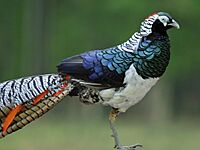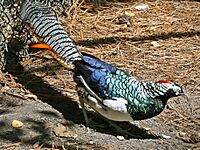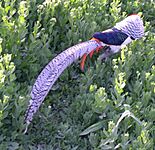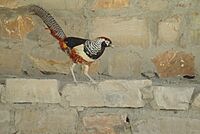Lady Amherst's pheasant facts for kids
Quick facts for kids Lady Amherst's pheasant |
|
|---|---|
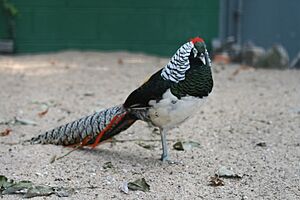 |
|
| Male at Parc Paradisio, Hainaut, Belgium | |
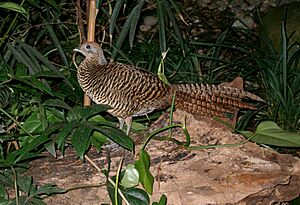 |
|
| Female | |
| Conservation status | |
| Scientific classification | |
| Genus: |
Chrysolophus
|
| Species: |
amherstiae
|
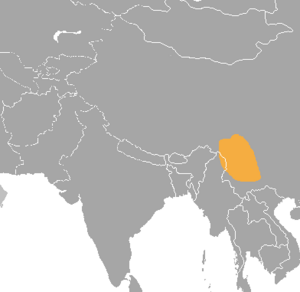 |
|
| Lady Amherst's Pheasant Chrysolophus amherstiae, range map | |
The Lady Amherst's pheasant (Chrysolophus amherstiae) is a beautiful bird. It belongs to the same group of birds as chickens and turkeys, called Galliformes. Its scientific name, Chrysolophus, comes from an Ancient Greek word meaning "with golden crest."
The English name and part of its scientific name, amherstiae, honor Sarah Amherst. She was important because she sent the first bird specimen to London in 1828. Sometimes, people also call this bird the Chinese copper pheasant. The Lady Amherst's pheasant is currently listed as "Least Concern" by the IUCN Red List. This means it is not considered to be in danger of disappearing.
Contents
Where These Birds Live
This pheasant naturally lives in southwestern China and the very northern part of Myanmar. However, people have also brought it to other places around the world.
For a while, a group of these pheasants lived on their own in England. They were mostly found in West Bedfordshire. Lady Amherst herself first brought these fancy pheasants to her land. This was near the Duke of Bedford's Woburn Abbey, where people also hunted the birds.
Even though people thought the wild pheasants in Britain had died out by 2015, some have been seen since then. For example, a Lady Amherst's pheasant was photographed in Taunton in May 2020. Another one was spotted in a garden in Scotland in March 2021.
What Lady Amherst's Pheasants Look Like
The Male Pheasant
The adult male Lady Amherst's pheasant is quite long, usually about 100 to 120 centimeters (40 to 48 inches). Its long tail makes up a big part of this length, about 80 centimeters (31 inches).
The male is easy to spot because of its amazing colors. It has a white and black "cape" around its neck and a bright red crest on its head. Its long tail is a grayish-white with black stripes. It also has red streaks near the base of its tail.
The male's chest and belly are white. Its throat has green scales, and its back is a dark green. The wings are a mix of blue and brown, and its rump (the area above its tail) is yellow. When the male wants to show off, it can raise its "cape."
This pheasant is very similar to the golden pheasant. However, the Lady Amherst's pheasant is a bit bigger. It also has a yellow eye with blue-green skin around it. Its beak is horn-colored, and its legs are blue-gray.
The Female Pheasant
The female Lady Amherst's pheasant is much less colorful than the male. She has duller, mottled brown feathers all over her body. She looks a lot like the female common pheasant, but her markings are finer.
She is also very similar to the female golden pheasant. However, the Lady Amherst's female has a darker head. Her underside is also cleaner, meaning it has fewer markings, compared to the female golden pheasant.
Even though the male is so colorful, these birds are very hard to see in their natural homes. They live in thick, dark forests with lots of plants on the ground. Because of this, we don't know much about how they behave in the wild.
What They Eat and How They Behave
Lady Amherst's pheasants look for food on the ground. They eat grains, leaves, and small bugs called invertebrates. At night, they fly up into trees to sleep safely.
While these birds can fly, they usually prefer to run away from danger. But if something startles them, they can suddenly fly upwards very fast. When they do this, their wings make a special sound. During the time of year when they mate, the male pheasant makes a loud, metallic call.
Images for kids
-
Lady Amherst's x golden pheasant cross. In a pure Lady Amherst's pheasant, the red crest starts roughly halfway between the cere to the crest tip (not at the beak), and the belly would be all white without any red or brown tainting.



